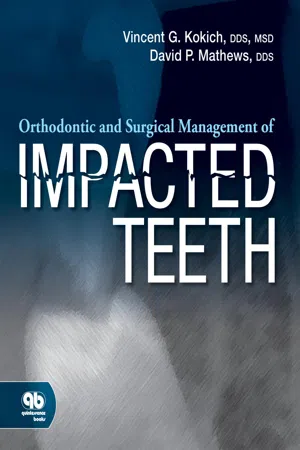![]()
Etiology
The most commonly impacted teeth are the mandibular third molars, followed by the maxillary canines, mandibular second premolars, and maxillary central incisors.1 Several causes of maxillary central incisor impaction have been documented, including crowding, 2 trauma,3,4 root dilaceration,5–9 presence of an odontoma,10,11 presence of a dentigerous cyst,12 or presence of a supernumerary tooth or mesiodens.13–16 Some mesiodentes are located in the maxillary midline, between the two central incisors. In this situation, the supernumerary tooth is not blocking the path of eruption of the maxillary central incisors, and all anterior teeth potentially could erupt normally, including the mesiodens. The solution for this problem is to extract the mesiodens and close the space between the maxillary central incisors orthodontically. However, in most situations, when a mesiodens is present, it is positioned lateral to the maxillary midline and blocks the path of eruption of either the right or left central incisor. If multiple supernumerary teeth are present, both central incisors could become impacted (Fig 1-1).
Fig 1-1 Multiple supernumerary teeth.
(a) This young patient had two supernumerary teeth that developed coronal to the maxillary central incisors. (b) The supernumerary teeth as well as all six maxillary anterior primary teeth were extracted to facilitate the eruption of the permanent maxillary incisors. (c and d) However, the follicles of the central incisors were damaged during the surgery, and, as a result, the lateral incisors erupted while the central incisors remained impacted.
If the supernumerary tooth or teeth are discovered early and extracted,17 the central incisor could erupt spontaneously (see Fig 1-2). However, the method of extraction and extent of damage to the surrounding area could disrupt the natural eruption of the central incisor(s) and result in impaction. A series of articles published by Marks et al18–22 emphasizes the importance of the integrity of the dental follicle during the normal eruptive process. In their experiments, the researchers intentionally and selectively damaged various parts of the developing tooth bud in an attempt to disrupt the eruptive process and cause impaction of the tooth. However, intentional injury to the root and various parts of the crown of the unerupted tooth did not prevent tooth eruption. But when the dental follicle was damaged or removed, eruption stopped. These researchers believe that the integrity of the dental follicle is critical to the normal eruption of any tooth.
Therefore, if the mesiodens or supernumerary tooth can be extracted without damaging the follicle of the subjacent central incisor, the impediment to eruption will be eradicated, and the impacted central incisor should erupt. This process is illustrated in Fig 1-2. This patient was 8 years old, and the maxillary left central incisor and both maxillary lateral incisors had erupted (see Fig 1-2a). However, the right central incisor had not erupted. A periapical radiograph revealed a supernumerary tooth that was apparently blocking the eruptive path of the right central incisor (see Fig 1-2b). A labial flap was elevated, and the supernumerary tooth was identified and removed without extracting the primary central incisor or damaging the follicle of the developing right central incisor. The flap was repositioned, and the teeth were allowed to erupt. After 1 year, the right central incisor had erupted spontaneously without orthodontic intervention (see Fig 1-2c). Therefore, if the supernumerary tooth is diagnosed early and removed surgically without compromising the follicle of the impacted central incisor, the submerged tooth should erupt spontaneously.
Fig 1-2 Interceptive removal of a supernumerary tooth.
(a) This patient was 7 years, 8 months old. Her maxillary right central incisor was impacted within the alveolus. (b) The panoramic radiograph showed that a supernumerary tooth was blocking the path of eruption of the central incisor. The supernumerary tooth was removed without damaging the follicle of the right central incisor. (c) Eventually, the maxillary right central incisor erupted spontaneously without any further intervention. (d) This patient’s occlusion was developing normally, and the parents chose not to proceed with any further orthodontic treatment.
However, in some situations, the proximity of the supernumerary tooth and the central incisor is so close that damage to the follicle of the impacted central incisor is unavoidable and inevitable. In other situations, an odontoma or dentigerous cyst may be present and in close proximity to the central incisor crown. Removal of the odontoma or cyst will usually damage the central incisor follicle, and the tooth will stop erupting. Finally, in some situations, a severely dilacerated root will cause impaction of the central incisor as a result of diversion of the tooth’s eruptive path, placing it in an oblique position within the alveolus (see Fig 1-9). In all of these situations, it is best to uncover the impacted central incisor at the same time that the other surgery is being done, assuming the root of the central incisor is adequately developed.
Preoperative Orthodontics
Usually, an impacted central incisor is recognized during the mixed dentition. At that time, all maxillary and mandibular central and lateral incisors are erupted, except for the impacted central incisor. The first step to facilitating spontaneous eruption is to extract any supernumerary teeth. If the tooth does not erupt autonomously, orthodontic treatment must be initiated to erupt the tooth.
Brackets should be placed on the remaining central incisor and the two maxillary lateral incisors. This bracket placement typically provides sufficient anchorage to erupt the impacted tooth. If the contralateral central incisor and adjacent lateral incisors are tipped toward one another, the space is opened using a compressed-coil spring. In this situation, it is necessary to place bands or brackets on the permanent maxillary first molars to provide anchorage during the course of orthodontic treatment.
After sufficient space has been established, a rectangular stabilizing wire is placed in the maxillary brackets. A loop may be placed in the archwire to temporarily anchor the attachment that will be placed on the impacted central incisor during the uncovering procedure. At this point, the patient is referred to the sur...



